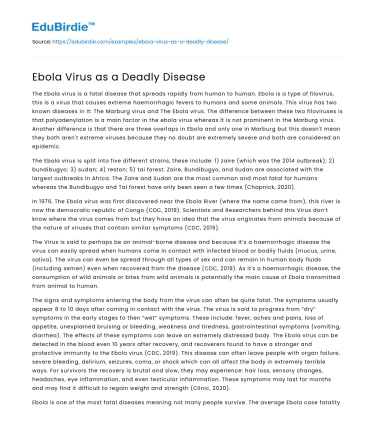The Ebola virus is a fatal disease that spreads rapidly from human to human. Ebola is a type of filovirus, this is a virus that causes extreme haemorrhagic fevers to humans and some animals. This virus has two known diseases in it: The Marburg virus and The Ebola virus. The difference between these two filoviruses is that polyadenylation is a main factor in the ebola virus whereas it is not prominent in the Marburg virus. Another difference is that there are three overlaps in Ebola and only one in Marburg but this doesn't mean they both aren't extreme viruses because they no doubt are extremely severe and both are considered an epidemic.
The Ebola virus is split into five different strains, these include: 1) zaire (which was the 2014 outbreak); 2) bundibugyo; 3) sudan; 4) reston; 5) tai forest. Zaire, Bundibugyo, and Sudan are associated with the largest outbreaks in Africa. The Zaire and Sudan are the most common and most fatal for humans whereas the Bundibugyo and Tai forest have only been seen a few times (Chapnick, 2020).
Save your time!
We can take care of your essay
- Proper editing and formatting
- Free revision, title page, and bibliography
- Flexible prices and money-back guarantee
In 1976, The Ebola virus was first discovered near the Ebola River (where the name came from), this river is now the democratic republic of Congo (CDC, 2019). Scientists and Researchers behind this Virus don’t know where the virus comes from but they have an idea that the virus originates from animals because of the nature of viruses that contain similar symptoms (CDC, 2019).
The Virus is said to perhaps be an animal-borne disease and because it’s a haemorrhagic disease the virus can easily spread when humans come in contact with infected blood or bodily fluids (mucus, urine, saliva). The virus can even be spread through all types of sex and can remain in human body fluids (including semen) even when recovered from the disease (CDC, 2019). As it's a haemorrhagic disease, the consumption of wild animals or bites from wild animals is potentially the main cause of Ebola transmitted from animal to human.
The signs and symptoms entering the body from the virus can often be quite fatal. The symptoms usually appear 8 to 10 days after coming in contact with the virus. The virus is said to progress from “dry” symptoms in the early stages to then “wet” symptoms. These include: fever, aches and pains, loss of appetite, unexplained bruising or bleeding, weakness and tiredness, gastrointestinal symptoms (vomiting, diarrhea). The effects of these symptoms can leave an extremely distressed body. The Ebola virus can be detected in the blood even 10 years after recovery, and recoverers found to have a stronger and protective immunity to the Ebola virus (CDC, 2019). This disease can often leave people with organ failure, severe bleeding, delirium, seizures, coma, or shock which can all affect the body in extremely terrible ways. For survivors the recovery is brutal and slow, they may experience: hair loss, sensory changes, headaches, eye inflammation, and even testicular inflammation. These symptoms may last for months and may find it difficult to regain weight and strength (Clinic, 2020).
Ebola is one of the most fatal diseases meaning not many people survive. The average Ebola case fatality rate is estimated at around 50%, but the death rate has varied from 25% to up to 90% in the past (WHO, 2020). In 2016 the total cases and deaths were identified, as seen in the graph. Guinea had an outstanding amount of deaths at 2,544 deaths out of 3,814 cases, the results that came from those cases were 11,325 deaths. The virus is also said to be more deadly than contagious, as the average number of people that can be infected by one single parent is on average 1.5-2.5 and the case fatality rate is 70%.
The healthcare systems were greatly affected as an additional problem caused by the Ebola virus, this then led to greater mortality and morbidity. A survey was done in 2013 as little was known about healthcare when the pandemic was in action, the survey was conducted to identify whether people were getting treated well and how the support system was managing throughout the tragic time. 67% of urban and 46% of rural respondents recognized that it was near impossible to access healthcare whilst the epidemic was around. In urban areas, only 20-30% of people seeking care were able to receive healthcare and in rural areas, there was only 70-80% able to access it (ASTMH, 2017). The healthcare systems were struggling immensely during the epidemic which created more patients to become sick as well as impact mental health as there were no support systems.






 Stuck on your essay?
Stuck on your essay?

